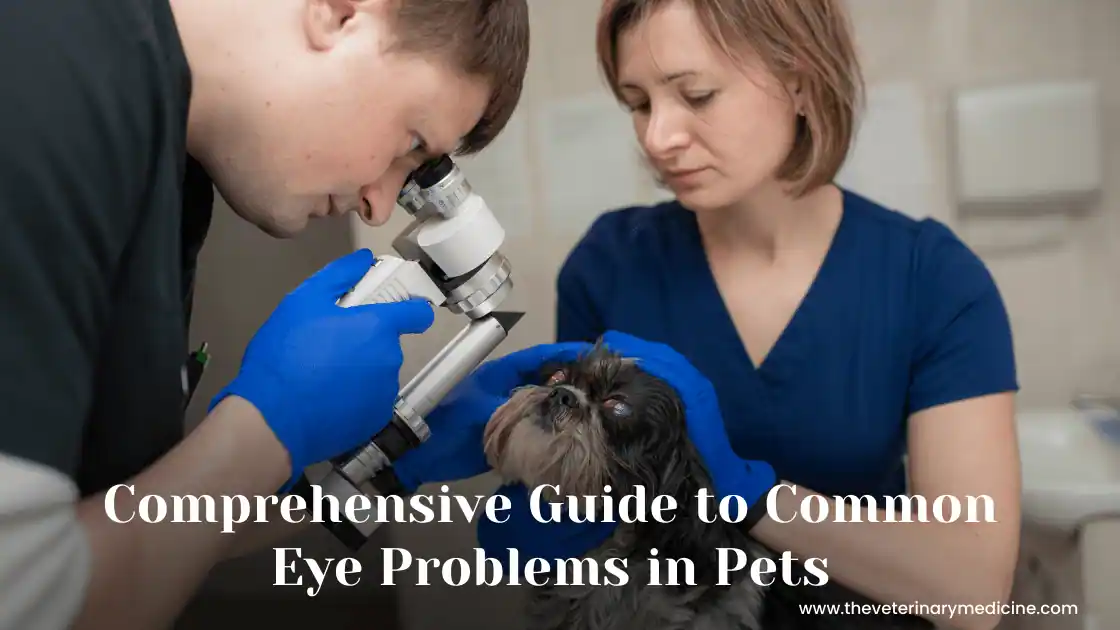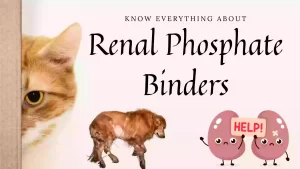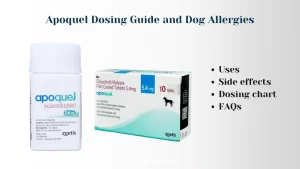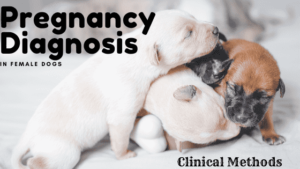Understanding the Symptoms, Causes, Treatments, Management, and Prevention of Common Eye Problems in Pets
Eye problems are common in pets like other health issues. Pets specially, dogs and cats suffer from eye problems like conjunctivitis, corneal ulcers, epiphora, cataract, glaucoma, cherry eye, entropion and ectropion. Recognition of early signs and diagnosis helps in the treatment options and implementation of preventive measures which are helpful in maintaining your pet’s vision and quality of life.
Common eye problems in pets:
Pet’s encounter different eye problems but some of them commonly / more frequently encountered. Here are a few of them with their causes and symptoms as follows:
- Conjunctivitis (Pink eye):
Conjunctivitis or pink eye is the inflammation of the conjunctiva i.e., the pink tissue lining the eyelids (palpebra) and covering the white part (sclera) of the eye. It can be caused by allergies, irritants, infections (bacterial, fungal or viral), or foreign objects in the eye. Symptoms include redness, squinting, discharge, and pawing at the eye. Treatment may involve removal of causative agents if any, eye drops (topical NSAID, antibiotics, steroids, antihistamines), systemic antibiotics and anti-inflammatory medications.
- Corneal ulcers:
Corneal ulcers are non-healing scratches or abrasions on the cornea, the transparent outer layer of the eye. They can be caused by scratches, sharp objects, foreign bodies, dry eyes, or trauma. Signs include squinting, pawing at the eye, tearing, opacity, and light sensitivity. Treatment may include antibiotics, pain management, and protective measures like an Elizabethan collar to prevent further damage. Sometimes may require surgery depending on the condition. Topical steroids are contraindicated in case of corneal ulcers and may lead to non-healing or further damage.
- Epiphora/ Excessive tear production:
This refers to excessive tearing, often causing staining of the fur and tear streak around the eye. It can be a symptom of an underlying condition like allergies, blocked tear or nasolacrimal ducts, corneal irritation/injury, or entropion (inward rolling of the eyelid). Treatment is symptomatic and may involve flushing of NLD and corrective surgery for entropion.
- Cataracts:
Similar to humans, pets can develop cataracts which is the clouding of the transparent lens inside the eye. This can gradually lead to loss of vision if not addressed timely. While more common in older pets, cataracts can also occur in younger animals due to genetics, diabetes, dietary factors, or trauma. Symptoms of cataract include whiteness or changes in lens, poor vision or bumping into objects. Surgery is a viable option for advanced cases, while early intervention may include specialized diets and medications.
- Glaucoma:
Glaucoma in dogs and cats arises due to different factors like closure of filtration angle, tumours, trauma etc and it results into increased pressure within the eye, damaging the optic nerve and potentially leading to painful eye and blindness. Glaucoma can be primary or secondary depending on the cause or aetiology. Symptoms include pain, squinting, redness, bulging of the eye, and changes in vision (loss of vision). Treatment often involves systemic and topical medications to reduce intraocular pressure and pain or surgical procedures to manage the condition.
- Cherry eye:
This is a prolapse of the nictitating membrane, also known as the “third eyelid,” which appears as a red mass in the corner of the eye. Irritation may lead to excessive tear production and secondary complications. While not always a problem, it can sometimes require surgery for correction.
- Entropion and ectropion:
These conditions involve inward or outward rolling of the eyelid, respectively. Some breeds are more prone to these eyelid disorders. This can irritate the cornea and cause excessive tearing. Treatment is usually corrective surgery.
It’s important to note that this list is not exhaustive, and other eye problems can affect pets like Horner’s Syndrome, Proptosis, Haw’s Syndrome, Dermoid Cysts, Retinal Atrophies, Lens Luxation, Uveitis, Keratitis, Keratoconjunctivitis (Dry Eye), Chemosis etc.
Common Signs of Eye Problems in Pets:
Recognising the signs of eye problem early is key in the diagnosis and management of eye problems. Some signs are common in case of different eye problems. Common symptoms that suggest eye issues include:
- Redness or inflammation
- Excessive tearing or discharge
- Squinting or blinking more than usual
- Cloudiness or change in eye color/ cornea
- Pupil-size changes or unequal pupil sizes
- Apparent irritation leading to pawing at the eye
- A visible swollen third eyelid
- Reduced vision or bumping into objects
If your pet exhibits any of these signs, it’s essential to consult with a veterinarian promptly.
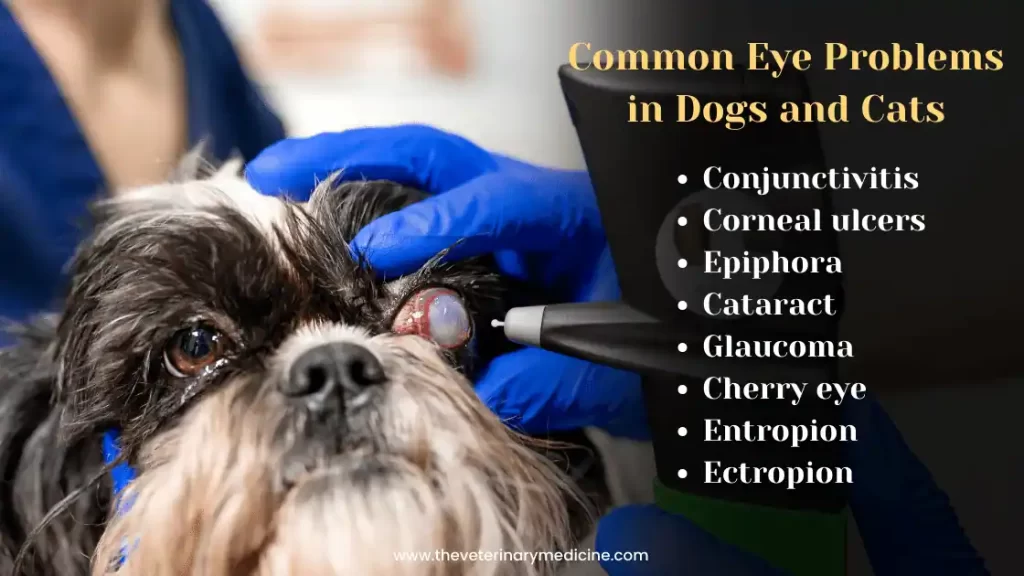
Treatment and Management of Eye Problems in Nutshell:
If you notice any signs of an eye problem in your pet without making delay consult a veterinarian immediately. Early diagnosis and treatment are essential for effective management, preventing further complications and vision loss.
When it comes to treating eye conditions, a multi-faceted approach may be required. The specific treatment your pet receives will depend on the diagnosis and the severity of the condition. Here are some common treatment options:
Oral Medications:
Veterinary care is paramount when dealing with eye problems in pets. Medications such as systemic antibiotics, antifungal, anti-inflammatory drugs, diuretics, ACE inhibitors, pain relievers and other medicines may be prescribed based on the specific condition. Supplements like vitamin A or other preparations can be added to promote healing or visual outcome.
Topical Medications:
- Antibiotic or antifungal eye drops: These are prescribed to prevent secondary infections and treat bacterial or fungal infections causing eye problems and discomfort.
- Anti-inflammatory eye drops: These helps in reducing swelling, inflammation, pain and discomfort. It may contain topical steroids, antihistamines, anaesthetics or NSAIDs depending on the lesion or problem.
- Artificial tears and tear stimulants: These are used to lubricate the eye in cases of dry eye. Common preparations contain hydroxymethyl cellulose or carboxymethyl cellulose. Cyclosporine and tacrolimus are commonly used to stimulate tear production in case of KCS depending on the stage.
- Other topical medications: May include ACE inhibitors like dorzolamide, Beta blockers like timolol, prostaglandin analogues like bimatoprost, autologous serum, platelet rich plasma, placental gel or other medications depending on the condition.
Surgical Intervention:
In some cases, surgery may be necessary to correct problems like cataract, glaucoma, corneal ulcers, ocular dermoid, eye lid tumours, entropion, ectropion, or cherry eye. Procedures like cataract surgery or correcting eyelid abnormalities can improve your pet’s quality of life. It’s essential to discuss the potential risks and benefits with your veterinarian before opting for surgery.
Management of eye problems:
Management strategies alongside treatment plays a vital role in your pet’s recovery and long-term eye health. Administering prescribed medications as directed, keeping the area clean, and monitoring for any changes are essential responsibilities for pet owners. Management may include:
- Using an Elizabethan collar (cone): This prevents your pet from rubbing or pawing at their eye. Self-mutilation can worsen the problem and prognosis.
- Cleaning the eye with a saline solution: If your vet has advised gently irrigate the eye with sterile normal saline or buffered saline solution. This can help remove any discharge or debris.
- Regular veterinary checkups: Never miss a follow up. These are crucial for monitoring the progress of treatment and overall eye health.
Preventing Eye Problems in Pets:
While some eye problems are breed specific and unavoidable due to age or genetics, several preventive measures can help reduce the risk of complications and maintain your pet’s eye health. Here are some preventive measures:
- Schedule veterinary checkups: Always understand your pet breed and if it is more susceptible for ocular problems then schedule your appointment. Routine eye examinations are essential, especially for senior pets, to catch problems in their early stages. This allows your vet to identify and address any potential eye problems early on.
- Keep your pet’s environment clean and free of debris: Eye irritation due to dirt, debris, stormy weather may lead to discomfort and eye problems. Keeping them away from these helps in prevention of foreign objects from entering the eye and causing scratches. A clean-living environment reduces the risk of eye infections. Regularly clean your pet’s bedding, toys, and living spaces to minimize the presence of irritants and allergens.
- Trim your pet’s facial hair: In breeds like Shih Tzu, Lhasa Apso, Poodle long facial hairs around the eyes can irritate or scratch the cornea. Well-trimmed facial hairs or cut can help in prevention of eye problems.
- Protect your pet’s eyes from harmful UV rays: UV rays can lead to eye problems like onset of cataract. Consider using pet goggles during intense outdoor activities.
- Maintain a healthy diet: Nutritional imbalance and deficiencies may lead to eye problems like dry eye (xerophthalmia), retinal degeneration/ atrophy, defective lens nutrition and much more. Well-balanced diet ensures your pet receives the necessary nutrients for optimal eye health.
- Be aware of breed predispositions: Some dog breeds are more prone to specific eye problems. Be vigilant with breeds like Pugs, Chow-Chow, Lhasa Apso, Saint Bernard, Shih Tzus, and Bulldogs.

Conclusions:
Most of the pets suffer from one or other eye problems in their lifetime. Recognizing, treating, and preventing common eye problems like corneal ulcers, epiphora, cherry eye, cataract, glaucoma, entropion, ectropion etc. will ensure that your pet companions enjoy a life filled with clear vision, vitality and quality of life. Regular veterinary check-ups, a balanced diet, and protective measures at early stage are the pillars of maintaining optimal eye health in pets.
FAQs on Eye Problems in Pets:
Q: How can I tell if my pet has an eye problem?
A: Signs like squinting, rubbing or pawing at the eye, redness, excessive tearing, discharge, changes in vision, and cloudiness in the eye can all indicate an eye problem. If you observe any of these, consult your veterinarian promptly.
Q: Can I use human or over-the-counter eye drops on my pet?
A: Absolutely not. Most of the human eye drops are not formulated for animals (different strengths or ingredients) and can have harmful side effects. Don’t use any human preparation until it’s recommended by your veterinarian. Always use pet-specific eye products recommended by your veterinarian.
Q: How often should I clean my pet's eyes?
A: The frequency of cleaning eyes depends on your pet’s individual needs and any specific instructions from your veterinarian. Generally, daily cleaning with eye wipes or with a damp, clean cloth may be sufficient for some pets, while others might not need it at all. Always use clean a vet-recommended solution and avoid using random solutions or normal water.
Q: Are certain breeds more prone to eye problems?
A: Yes, certain breeds are predisposed to specific eye conditions. Like brachycephalic breeds (Pugs, Shih Tzu, Pekingese) may be more prone to corneal ulcers, ocular trauma while some dog breeds are genetically predisposed to cataracts like Cocker Spaniels.
Q: Can diet affect my pet's eye health?
A: Yes, a balanced diet rich in essential vitamins like vitamin A, C, and E, amino acids and other nutrients, can support eye health. Always choose high-quality pet food and supplements as advised by your vet.
Q: Is there anything I can do to help my pet cope with vision loss?
If your pet experiences vision loss, several measures can help them adapt:
- Maintain a consistent environment: Don’t move furniture frequently, and ensure familiar landmarks are present.
- Use verbal cues and gentle guidance: Help your pet navigate their surroundings and avoid obstacles.
- Provide enrichment activities: Utilize smell and sound-based toys to keep your pet mentally and physically stimulated.
- Be patient and understanding: Adjusting to vision loss can be challenging for pets. Offer them extra love, support, and reassurance.
Remember: Early detection and treatment are critical for preserving your pet’s vision and overall well-being. By being aware of common eye problems, their treatment options, and preventative measures, you can become a proactive advocate for your pet’s eye health.
References:
For more detailed information on these conditions, treatments, and eye care for your pets, refer to the following resources:
- David J. Maggs, Paul E. Miller and Ron Ofri. “Slatter’s Fundamental of Veterinary Ophthalmology: 6th Edition”. Publisher: Elsevier.
- Kirk N. Gelatt and Caryn E. Plummer. “Essentials of Veterinary Ophthalmology: 4th” Publisher: Wiley-Blackwell.


